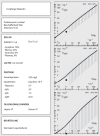[Current cerebrospinal fluid diagnostics for pathogen-related diseases]
- PMID: 23371378
- PMCID: PMC7095826
- DOI: 10.1007/s00115-012-3701-8
[Current cerebrospinal fluid diagnostics for pathogen-related diseases]
Abstract
Cerebrospinal fluid (CSF) analysis is of utmost importance to establish an early diagnosis of central nervous system (CNS) infections and to start appropriate therapy. The CSF white cell count, lactate concentration and total protein levels are usually available very quickly even from non-specialized laboratories and the combination of these parameters often provides sufficient information for decision-making in emergency cases. It is, however, not always possible to identify the underlying infective agent despite further CSF analyses, such as bacterial and fungal staining, evaluation of the blood-CSF barrier function, intrathecal immunoglobulin synthesis and oligoclonal IgG bands. Therefore, close communication between the laboratory and the clinician is an important prerequisite to specify additional pathogen-related diagnostic measures for successful confirmation of the diagnosis.
Für die Differenzialdiagnose und die Behandlung einer Infektion des Zentralnervensystems kommt dem Liquorbefund eine zentrale Bedeutung zu. Zusammen mit den klinischen und mikrobiologischen Befunden sollte die Art der Infektion rasch erkannt und daraus eine spezifische Behandlung abgeleitet werden.
Bereits durch die Konstellation weniger Parameter der Liquorgrundanalytik (Zellzahl, Laktat, Gesamtproteingehalt), die innerhalb kurzer Zeit auch von nicht spezialisierten Zentrallabors geliefert werden, stehen meist die wesentlichen und für die weitere Diagnostik und Therapie entscheidenden Informationen zur Verfügung. Allerdings können die definitiven Diagnosen auch nach Erhalt weiterer Liquorparameter (Zellbilder, Erregerdirektfärbungen, Blut-Liquor-Schrankenfunktion, intrathekale Immunglobulinsynthese, oligoklonale IgG-Banden) ungeklärt bleiben. Daher ist der enge Informationsaustausch zwischen dem Labor und den Klinikern eine wichtige Voraussetzung zur Gestaltung der erweiterten erregerbasierten Spezialdiagnostik und somit erfolgreichen Diagnosestellung.
References
-
- Petereit H-F, Sindern E, Wick M (2007) Leitlinien der Liquordiagnostik und Methodenkatalog der Deutschen Gesellschaft für Liquordiagnostik und Klinische Neurochemie. Springer Medizin, Heidelberg
-
- Felgenhauer K, Beuche W (1999) Labordiagnostik neurologischer Erkrankungen. Thieme, Stuttgart
Publication types
MeSH terms
Substances
LinkOut - more resources
Full Text Sources
Other Literature Sources





